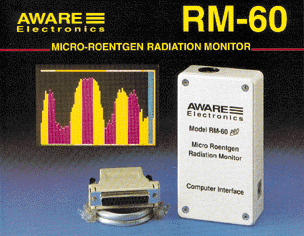Geiger Counter
or
Geiger Muller Detector
or
Geiger Muller Detector
Local Backround and Muon radiation data. Graphs and data in EXCEL Format.
Data is in one minute increments, graphs show weekly and monthly averages.
Click here for Current Data.
Data is in one minute increments, graphs show weekly and monthly averages.
Click here for Current Data.

Radiation can be detected in many ways. A common method is the Geiger counter or Geiger Muller Detector.
This type of detection was invented by Hans Geiger in 1908 and further developed by Walther Muller in 1928.
This type of detector is an ionization detector consisting of a tube containing a low pressure inert gas. There
are two electrodes in the tube. The outside of the tube is sometimes used as one electrode, the other electrode
is usually a wire run through the center of the tube (fig 1). A high voltage DC is applied between the
electrodes. Radiation that passes through the tube causes the gas to ionize. The high voltage attracts and
accelerates the ions causing further ionization, this results in an intense but brief pulse current between the
electrodes. To prevent continuous conduction, various other gases are added to the tube. The electronics in
the counter detect and record these pulses. The construction of the tube, the applied voltage and the amount
and type of gases used determined the amount of radiation the tube can measure.
This type of detection was invented by Hans Geiger in 1908 and further developed by Walther Muller in 1928.
This type of detector is an ionization detector consisting of a tube containing a low pressure inert gas. There
are two electrodes in the tube. The outside of the tube is sometimes used as one electrode, the other electrode
is usually a wire run through the center of the tube (fig 1). A high voltage DC is applied between the
electrodes. Radiation that passes through the tube causes the gas to ionize. The high voltage attracts and
accelerates the ions causing further ionization, this results in an intense but brief pulse current between the
electrodes. To prevent continuous conduction, various other gases are added to the tube. The electronics in
the counter detect and record these pulses. The construction of the tube, the applied voltage and the amount
and type of gases used determined the amount of radiation the tube can measure.

Fig 1
